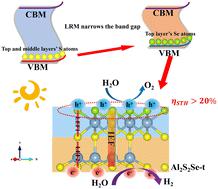当前位置:
X-MOL 学术
›
Catal. Sci. Technol.
›
论文详情
Our official English website, www.x-mol.net, welcomes your feedback! (Note: you will need to create a separate account there.)
Layerwise replacement method to achieve high solar-to-hydrogen efficiency for photocatalytic water splitting: a first principles study
Catalysis Science & Technology ( IF 4.4 ) Pub Date : 2024-08-08 , DOI: 10.1039/d4cy00688g Chuye Quan 1, 2 , Shilei Ji 1 , Ruijia Yao 1 , Ming Du 1 , Chen Chen 3 , Xiaoyang He 3 , Ran Cai 4 , Jianping Yang 3 , Xing'ao Li 1, 3
Catalysis Science & Technology ( IF 4.4 ) Pub Date : 2024-08-08 , DOI: 10.1039/d4cy00688g Chuye Quan 1, 2 , Shilei Ji 1 , Ruijia Yao 1 , Ming Du 1 , Chen Chen 3 , Xiaoyang He 3 , Ran Cai 4 , Jianping Yang 3 , Xing'ao Li 1, 3
Affiliation

|
Atomically layered stacking (ALS) two-dimensional (2D) materials, owing to their superior electrical properties and flexible tunability in addition to the advantages of traditional 2D materials, have garnered widespread attention in recent years. However, when used as photocatalysts for overall water splitting (OWS), many of them face challenges like low Solar-to-Hydrogen (STH) efficiency and insufficient driving force for photoinduced redox reactions. Here, using Al2X3 (X = S, Se) as samples, we demonstrate the potential of the Layerwise Replacement Method (LRM) in reducing the materials' bandgap, improving their light absorption performance, and boosting the STH efficiency. As anticipated, the Al2S2Se-t and Al2TeSe2-m monolayers demonstrate STH efficiencies exceeding 20%, surpassing the performance of the majority of reported photocatalysts. Additionally, under light excitation, the OER reaction on the Al2S2Se-t monolayer is exothermic, while on the Al2TeSe2-m monolayer, the OER energy barrier is reduced to 0.431 eV. Notably, on both materials, the HER energy barriers are approaching 0 eV. The improvement of these properties is primarily ascribed to the modulation of the materials' bandgap via the LRM, and secondarily to the reconstruction of the vertically intrinsic electric field (IEF). Our work not only offers a fresh perspective for the precise manipulation of atomically layered stacked 2D materials but also provides a rational strategy for designing novel and outstanding photocatalysts.
中文翻译:

分层置换方法实现光催化水分解太阳能-氢效率高:第一原理研究
原子层状堆叠(ALS)二维(2D)材料除了具有传统2D材料的优点外,由于其优越的电学性能和灵活的可调谐性,近年来引起了广泛的关注。然而,当用作整体水分解(OWS)的光催化剂时,它们中的许多面临着太阳能制氢(STH)效率低和光诱导氧化还原反应驱动力不足等挑战。在这里,我们以 Al 2 X 3 (X = S, Se) 作为样品,展示了分层替换法 (LRM) 在减小材料带隙、改善其光吸收性能和提高 STH 效率方面的潜力。正如预期的那样,Al 2 S 2 Se-t 和 Al 2 TeSe 2 -m 单层的 STH 效率超过 20%,超过了大多数报道的光催化剂的性能。此外,在光激发下,Al 2 S 2 Se-t单层上的OER反应是放热的,而在Al 2 TeSe 2 -m单层上,OER能垒降低至0.431 eV。值得注意的是,这两种材料的 HER 能垒都接近 0 eV。这些特性的改善主要归因于通过LRM 对材料带隙的调制,其次归因于垂直本征电场 (IEF) 的重建。 我们的工作不仅为原子层状堆叠二维材料的精确操控提供了新的视角,而且为设计新颖且出色的光催化剂提供了合理的策略。
更新日期:2024-08-13
中文翻译:

分层置换方法实现光催化水分解太阳能-氢效率高:第一原理研究
原子层状堆叠(ALS)二维(2D)材料除了具有传统2D材料的优点外,由于其优越的电学性能和灵活的可调谐性,近年来引起了广泛的关注。然而,当用作整体水分解(OWS)的光催化剂时,它们中的许多面临着太阳能制氢(STH)效率低和光诱导氧化还原反应驱动力不足等挑战。在这里,我们以 Al 2 X 3 (X = S, Se) 作为样品,展示了分层替换法 (LRM) 在减小材料带隙、改善其光吸收性能和提高 STH 效率方面的潜力。正如预期的那样,Al 2 S 2 Se-t 和 Al 2 TeSe 2 -m 单层的 STH 效率超过 20%,超过了大多数报道的光催化剂的性能。此外,在光激发下,Al 2 S 2 Se-t单层上的OER反应是放热的,而在Al 2 TeSe 2 -m单层上,OER能垒降低至0.431 eV。值得注意的是,这两种材料的 HER 能垒都接近 0 eV。这些特性的改善主要归因于通过LRM 对材料带隙的调制,其次归因于垂直本征电场 (IEF) 的重建。 我们的工作不仅为原子层状堆叠二维材料的精确操控提供了新的视角,而且为设计新颖且出色的光催化剂提供了合理的策略。





































 京公网安备 11010802027423号
京公网安备 11010802027423号